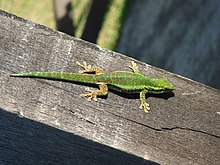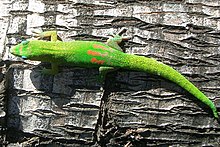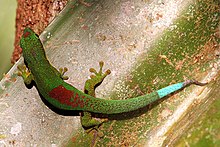Day geckos
| Day geckos | ||||||||||||
|---|---|---|---|---|---|---|---|---|---|---|---|---|

Madagascar day gecko ( Phelsuma madagascariensis ) |
||||||||||||
| Systematics | ||||||||||||
|
||||||||||||
| Scientific name | ||||||||||||
| Phelsuma | ||||||||||||
| Gray , 1825 |
The day geckos or Phelsumen ( Phelsuma ) are a genus of small lizards from the family of geckos (Geckonidae). Its most common representative is the palm day gecko ( Phelsuma dubia ). In contrast to the majority of the other geckos, Phelsumen are diurnal except for Phelsuma guentheri , other diurnal geckos belong to the genera Lygodactylus , Sphaerodactylus , Quedenfeldtia and Gonatodes . Besides Uroplatus, Phelsuma is the only gecko genus that is listed in Appendix 2 of the Washington Convention on Species Protection (exception: Phelsuma guentheri is listed in Appendix 1).
features
The coloration of the day geckos ranges from simple green with splashes of color to complex yellow-blue patterns. The total length of Phelsumen ranges from around 85mm to over 300mm, with most species reaching just under 200mm. They have round pupils and no eyelids. The originally existing upper and lower eyelids have grown together in the course of evolution and have developed into a transparent membrane. On both sides behind the eardrum is the endolymphatic apparatus, which is often referred to as the calcic sac. The endolymphatic apparatus is composed of a bag-shaped endolymphatic sac and an afferent duct, the endolymphatic duct . These two structures contain calcium . This organ serves both as a balance organ and as a calcium store. The females use this store to produce eggshells. The sexes can mainly be distinguished by the strongly developed femoral pores above the cloacal region in males . The thumbs are short compared to the rest of the toes. The scales on the underside of the toes are called subdigital lamellae. They are arranged in several longitudinal rows. The sub-digital lamellae are covered on one side with 80–120 micrometer long setae (adhesive bristles). These setae in turn split up into about 1000 spatulae each at the end of a plate . These spatulae can claw into the smallest unevenness of a substrate, which is why phelsumen can also adhere to apparently smooth surfaces.
Way of life and behavior
Phelsumens are probably tertiary diurnal. This means that day geckos evolved from one or more nocturnal gecko species, which in turn descend from diurnal ancestors. A clue that confirms this theory is the evidence of efficient visual cells in the eye of the day geckos, which suggests nocturnal ancestors. Phelsumens are also counted among the thigmothermic animals. It is typical for thigmothermic animals that they spend most of the day in the shade after a relatively short period of thermal adaptation. In addition, the body temperature is only slightly higher than the ambient temperature. Animals that like to be in the sun are called heliothermal .
distribution
Day geckos are found mainly on some islands in the Indian Ocean . Their main occurrence is in Madagascar , where the spread to other islands is likely to originate. From here they spread to the archipelagos in the Indian Ocean such as the Comoros , Seychelles , Andamans , Mascarene Islands and the Southeast African mainland. Endemic species live on many islands . These include the species Pasteur's day gecko ( Phelsuma pasteuri ) and black-stripe day gecko ( Phelsuma nigristriata ) native to Mayotte , which are not found on the other islands of the Comoros. Human- introduced populations exist in Florida and Hawaii .
threat
The rapid destruction of primary forests and the construction of gigantic hotel complexes on the bank zones and the use of insecticides associated with the latter are a strong threat to the often very "island-like" residual occurrences of the phelsumen. Introduced animals contribute to their destruction.
nutrition
Phelsumens feed on various insects or other invertebrates . Day geckos also like to eat nectar , pollen and probably ripe fruits such as B. Bananas .
Species and subspecies
Probably the first written records about Phelsumen come from François Leguat ( 1708 ). He reported of dark colored lizards on the island of Rodrigues , which were the now extinct species Phelsuma gigas . The genus Phelsuma was first described under this generic name in 1825 by the British zoologist John Edward Gray and named after the Dutch doctor Murk van Phelsum . About 70 species and subspecies have been described so far. Two species of phelsuma, ( Phelsuma gigas and Phelsuma edwardnewtoni ) are considered extinct. The extinction of these species was likely caused by the destruction of their biotopes and introduced domestic animals. 51 species are currently recognized. P. parva and P. dorsivittata , which were reestablished as species in 2010, are not listed in the Reptile Database :
-
Phelsuma abbotti
- Phelsuma abbotti abbotti
- Phelsuma abbotti chekei
- Phelsuma abbotti sumptio
- Phelsuma andamanensis
- Phelsuma antanosy
-
Phelsuma astriata
- Phelsuma astriata astriata
- Phelsuma astriata semicarinata
- Phelsuma barbouri
- Phelsuma berghofi
- Phelsuma borai
-
Phelsuma borbonica
- Phelsuma borbonica borbonica
- Phelsuma borbonica agalegae
- Phelsuma breviceps
- Phelsuma cepediana
- Phelsuma comorensis
- Phelsuma dorsivittata
- Phelsuma dubia
- Phelsuma edwardnewtoni
- Phelsuma flavigularis
- Phelsuma gigas
- Phelsuma grandis
- Phelsuma gouldi
- Phelsuma guentheri
- Phelsuma guimbeaui
- Phelsuma guttata
- Phelsuma hielscheri
- Phelsuma hoeschi
- Phelsuma inexpectata
- Phelsuma kely
- Phelsuma klemmeri
- Phelsuma kochi
-
Phelsuma laticauda
- Phelsuma laticauda laticauda
- Phelsuma laticauda angularis
-
Phelsuma lineata
- Phelsuma lineata lineata
- Phelsuma lineata bombetokensis
- Phelsuma lineata elanthana
- Phelsuma lineata punctulata
-
Phelsuma madagascariensis
- Phelsuma madagascariensis madagascariensis
- Phelsuma madagascariensis boehmei
- Phelsuma malamakibo
- Phelsuma masohoala
-
Phelsuma modesta
- Phelsuma modesta modesta
- Phelsuma modesta isakae
- Phelsuma modesta leiogaster
- Phelsuma mutabilis
- Phelsuma nigristriata
- Phelsuma ornata
- Phelsuma parkeri
- Phelsuma parva
- Phelsuma pasteuri
- Phelsuma pronki
-
Phelsuma pusilla
- Phelsuma pusilla pusilla
- Phelsuma pusilla hallmanni
-
Phelsuma quadriocellata
- Phelsuma quadriocellata quadriocellata
- Phelsuma quadriocellata bimaculata
- Phelsuma quadriocellata lepida
- Phelsuma ravenata
- Phelsuma robertmertensi
- Phelsuma roesleri
- Phelsuma rosagularis
- Phelsuma seippi
- Phelsuma serraticauda
- Phelsuma standingi
-
Phelsuma sundbergi
- Phelsuma sundbergi sundbergi
- Phelsuma sundbergi ladiguensis
- Phelsuma sundbergi longinsulae
-
Phelsuma v-nigra
- Phelsuma v-nigra v-nigra
- Phelsuma v-nigra anjouanensis
- Phelsuma v-nigra comoraegrandensis
- Phelsuma v-nigra pasteuri , see Phelsuma pasteuri
- Phelsuma vanheygeni
literature
- Oliver Drewes: Compact knowledge of day geckos. The genus Phelsuma. Portraits of the most popular species. VIVARIA Verlag, Meckenheim 2006, ISBN 3-9810412-1-6 .
- Hans-Peter Berghof: Day geckos. The genus Phelsuma. Maintenance and propagation. Natur-und-Tier-Verlag, Münster 2005, ISBN 3-937285-45-8 .
- Heiko Werning, Thomas Wilms (Red.): Taggeckos (= Draco. Jg. 3, No. 11, ISSN 1439-8168 ), Natur-und-Tier-Verlag, Münster 2002.
- Gerhard Hallmann, Jens Krüger, Gerd Trautmann: Fascinating day geckos. The genus Phelsuma. Natur-und-Tier-Verlag Schmidt, Münster 1997, ISBN 3-931587-10-X .
- Friedrich-Wilhelm Henkel, Wolfgang Schmidt (ed.): Amphibians and reptiles of Madagascar, the Mascarene, Seychelles and Comoros. Ulmer, Stuttgart 1995, ISBN 3-8001-7323-9 .
Individual evidence
- ↑ a b c Sara Rocha, Herbert Rösler, Philip-Sebastian Gehring, Frank Glaw , David Posada, D. James Harris, Miguel Vences : Phylogenetic systematics of day geckos, genus Phelsuma, based on molecular and morphological data (Squamata: Gekkonidae). In: Zootaxa. 2429, 2010, pp. 1–28, digital version (PDF; 1.46 MB) .
- ↑ Phelsuma in The Reptile Database ; Retrieved November 24, 2014.
- ↑ Frank Glaw, Philip-Sebastian Gehring, Jörn Köhler, Michael Franzen, Miguel Vences: A new dwarf species of day gecko, genus Phelsuma, from the Ankarana pinnacle karst in northern Madagascar. In: Salamandra. Volume 46, No. 2, 2010, ISSN 0036-3375 , pp. 83-92.
Web links
- Phelsuma in The Reptile Database ; Retrieved November 24, 2014.
- Phelsuma-World






